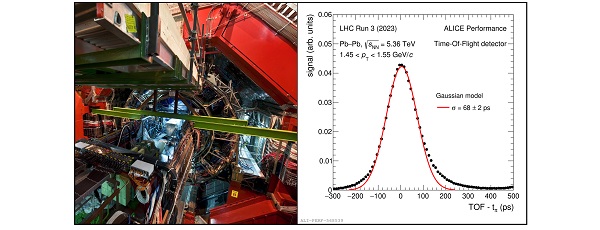In 2022, the LHC hadron collider began the Run 3 phase, and the Time of Flight (TOF) detector of the ALICE experiment entered its second decade of use.
The apparatus, built under the responsibility of the ALICE group of Bologna with the fundamental contribution of the section services, is made up of strips of high-performance Multigap Resistive Plate Chambers (MRPC) and covers the central rapidity region of ALICE for an area active total of 140 m2 segmented with more than 150,000 reading channels.
The ALICE TOF detector completed the readout electronics upgrades in early July 2022. This involved the production of a new readout board designed by INFN Bologna and using high-speed optical links.
In October 2023, ALICE collected the first Pb-Pb collisions, and the TOF was able to perform a calibration at levels similar to those of Run 2.
Thanks to a new calibration campaign, it was possible to significantly improve the temporal performance, exceeding, as already in Run 2, the 80 ps of resolution envisaged in the initial specifications of the project.
Thanks to its excellent performance and excellent temporal resolution, since 2009 the apparatus has allowed the identification of particles produced at the LHC at collision energies never before achieved in a laboratory.
This feature constitutes one of the pillars of the ALICE physics program, to which the TOF detector contributes in a crucial way.
The result achieved with this calibration confirms that the performance of the detector remains unchanged after 15 years of operations.
The ALICE group of Bologna oversaw the analysis that led to this result, which is expected to be published in an international journal.


